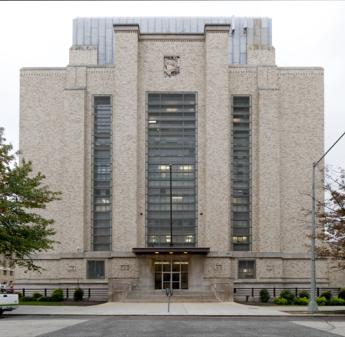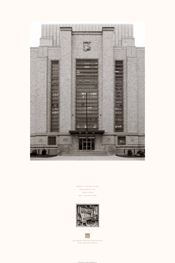Location: 325 13th St SW, Washington, DC 20024
History
In April 1931, the U.S. Department of the Treasury announced its plan to construct the Central Heating Plant, which would furnish steam to twenty-six federal buildings in Washington. The government stated that special attention would be given to the design of the new structure, and the U.S. Commission of Fine Arts (CFA) would review all plans.
At the turn of the twentieth century, growing concern over the disjointed appearance of the National Mall and the blighted neighborhood surrounding it led to the McMillan Plan of 1901, which, incorporating the ideals of the City Beautiful movement and the L’Enfant Plan of 1791, recommended that Washington’s monumental core be redeveloped as an enclave of classically inspired public buildings. Plans went largely unrealized until the Public Buildings Act of 1926 authorized the government to hire private architects and spurred a large-scale building program.
As new federal buildings began rising along the Mall, the need for an efficient heating system became critical. The government selected prominent French-American architect Paul Philippe Cret, who also designed the Organization of American States building and the Folger Shakespeare Library in Washington, to develop plans. Cret met with the CFA throughout 1931 as it reviewed the smokestack height and exterior design. Responding to concerns over his initial design, which included three tall smokestacks that dramatically affected Washington’s skyline, Cret incorporated the stacks within the building but allowed them to rise to a height at which fumes would not be objectionable to occupants of nearby buildings.
When the cornerstone was laid on July 7, 1933, the $5.7 million facility was characterized as the largest heating plant in the world. Construction proceeded quickly, and in January 1934 workers delivered the first load of coal to the plant. By 1936, the plant’s six boilers were heating seventy-one public buildings. In 1948, the West Heating Plant was constructed in Georgetown to share heat production for federal buildings in Washington. Despite numerous equipment changes, the Central Heating Plant retains its original configuration, materials, and function. In 2007, it was listed in the National Register of Historic Places.
Architecture
Described by the Works Progress Administration as “a forceful example of functional design” in a 1937 visitors guide to Washington, the Central Heating Plant was hailed for both its architecture and efficiency. Architect Paul Philippe Cret designed the monolithic steel and masonry main building in the Art Deco style, characterized by a stepped facade, linear composition with walls broken into vertical planes by long expanses of recessed windows, and stylized ornamentation.
Located in the northwest corner of a site bounded by Twelfth, Thirteenth, C, and D streets, the six-story variegated buff, brown, and yellow brick building is symmetrically designed with a limestone base. A continuous limestone string course separates the first floor from the upper floors, which contain vertically arranged industrial awning windows. The windows rhythmically break up the expansive elevations on the west, north and south.
Fronting Thirteenth Street, the symmetrical west facade is articulated by a projecting tower and central main entrance. Limestone stairs flanked by rounded limestone cheek walls lead to the entrance sheltered by a streamlined metal overhang. Aluminum-frame sidelights and transom surround double glass doors, and are encased within a rounded limestone frame.
On the first floor, four terracotta panels depict machinery housed within the building: a generator, heat exchanger, blower, and safety valve. A centrally located stack of steel-frame windows extends from the second to the fifth floor. Projecting brick bays framing the windows are flanked by narrow vertical window stacks, which are in turn framed by brick buttresses. Above the central stack of windows, a terracotta stylized panel illustrates the heating plant boiler. A denticulate classicized cornice caps the entrance block. A steel-framed screen wall with a metal panel roof, added in 1973, tops the building.
The secondary elevations contain architectural details similar to those found on the facade, including vertical bays of industrial awning windows alternating with brick buttresses, and a classical cornice. Facing Twelfth Street and obscuring the original east elevation, the 1958 six-story refrigeration plant addition, while designed to echo the original plant, has wider bays and slightly different brick hues.
The Central Heating Plant main building’s interior was designed primarily for utilitarian use, and therefore has large mechanical spaces necessary to hold boiler equipment. The first floor lobby and stair hall are accessed from the west, or main, entrance. The lobby is a small, one-story space finished in a brown-veined marble and brown-toned terrazzo floors framed by a black granite border. Original decorative vent covers adorn the east wall of the lobby. Two wooden and glass panel doors lead to the mechanical rooms behind the lobby. A small stair hall located at the north end of the lobby originally led to offices for workers. The stairway is u-shaped and contains original terrazzo treads and a stylized metal balustrade. In the mechanical spaces, steel catwalks run between equipment.
Mechanical equipment has been continually repaired and replaced since the plant opened in 1934. While still capable of running on coal, the plant now runs on natural gas and uses oil only as an emergency fuel source. The two remaining original boilers were significantly modified during the mid-1990s and converted to firing of natural gas and distillate fuel oil. Today, the plant services about one hundred Washington buildings.
Significant Events
- 1931: Treasury Department announces plan to construct Central Heating Plant.
- 1933: Assistant Secretary of the Treasury L.M. Roberts lays cornerstone. Plant operations begin the next year.
- January 1937: WPA records daily plant statistics: 15 million pounds of steam produced from 1.8 million gallons of water and 700 tons of coal.
- 1948: West Heating Plant constructed in Northwest Washington to share heat production with Central Heating Plant.
- 1958: Refrigeration plant addition constructed.
- 2007: Central Heating Plant listed in National Register of Historic Places.
Facts
- Architect: Paul Philippe Cret
- Architectural Style: Art Deco
- Construction Dates: 1933-1934
- GSA Building Number: DC0001ZZ
- National Register of Historic Places Landmark Status: National Register Listed
- Primary Materials: Brick, limestone, and steel
- Prominent Features: Stepped, variegated brick facade with tall industrial awning windows and buttresses; terracotta sculptural panels with stylized depictions of plant machinery
Poster download
Download the poster [PDF - 205 KB]

 U.S. General Services Administration
U.S. General Services Administration

